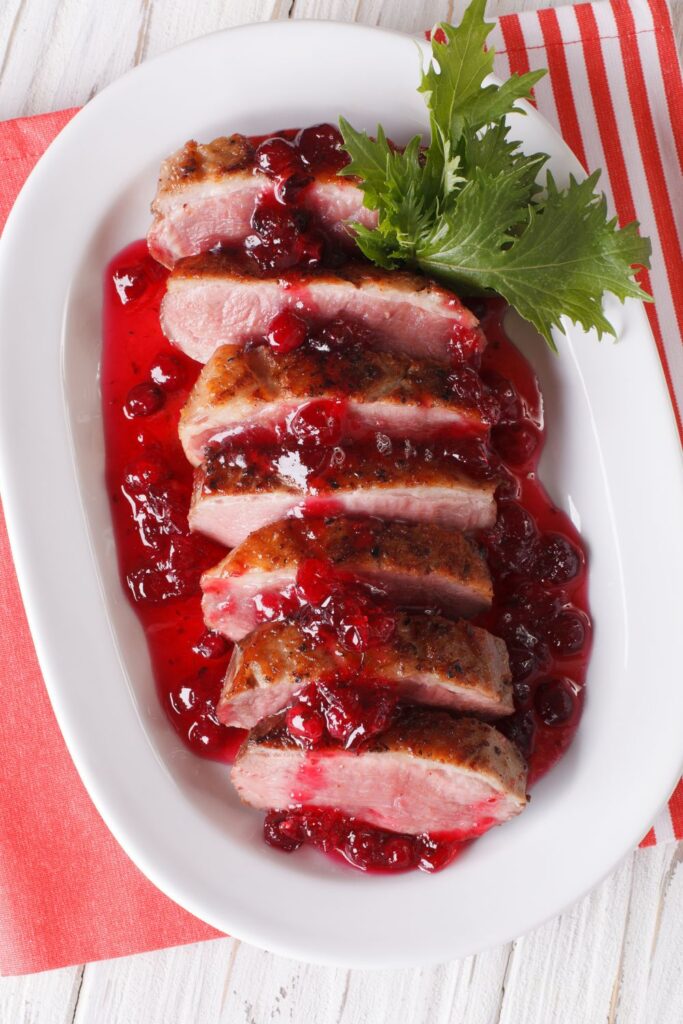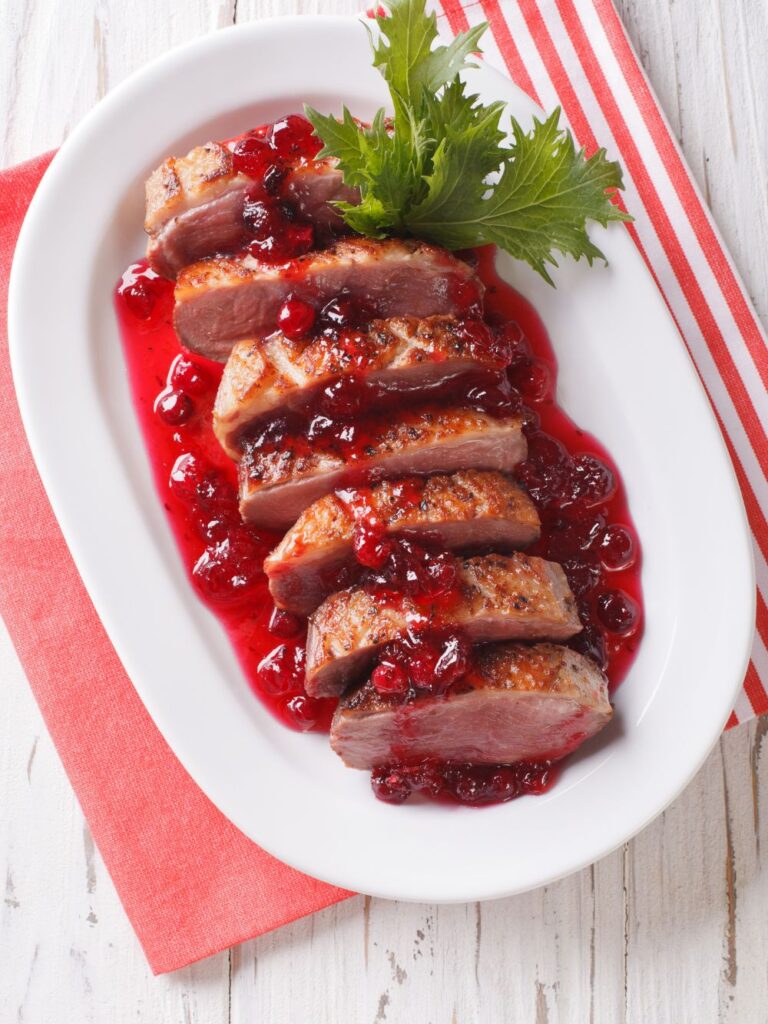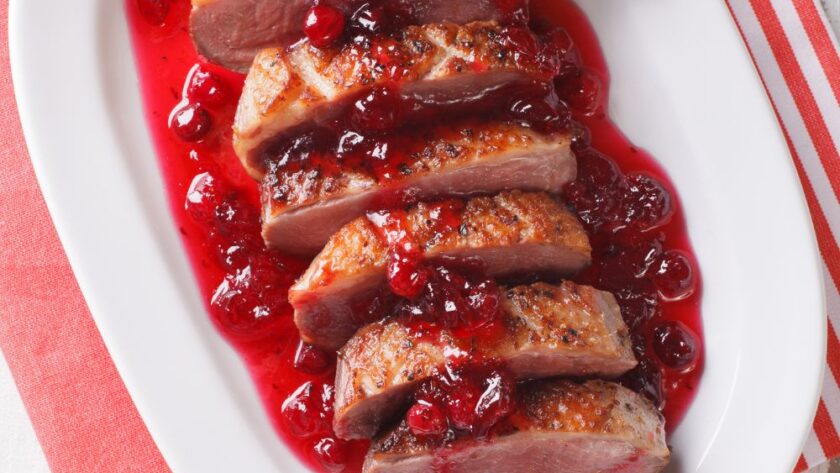Cooking duck for the first time feels a bit like hosting your first proper dinner party — thrilling, slightly nerve-racking, and almost guaranteed to involve one brief panic. I remember the first time I tried it, thinking, “This is going to be either genius or a greasy disaster.” I’d watched James Martin make it look effortless, flipping duck breasts like he was flipping pancakes. Mine stuck. I cursed. And then I tasted it… and everything was forgiven.
The secret? It’s all in the fat. Duck has loads of it, and you’ve got to coax it out slowly. But when you do — oh, it rewards you. Crisp skin, juicy meat, and that deep, almost gamey richness that feels wildly indulgent. And paired with the blackberry sauce? It’s date-night-on-a-weeknight kind of special.
Why You’ll Love It
- Crispy skin, juicy inside — basically the holy grail of meat.
- The sauce is next-level — fruity, savoury, a bit boozy… what’s not to love?
- Restaurant vibes at home — looks fancy, feels impressive.
- Great for leftovers — slice it up cold for salads or sandwiches.
- Quick cook time — 30 minutes start to finish, but it feels like a feast.
- You get to save duck fat — roast potatoes just got better.
Ingredients
- 2 Magret duck breasts (about 12–16 oz each)
- Salt and black pepper
- 2 shallots, peeled and diced
- ½ cup good blackberry jam
- 2 tsp all-purpose flour
- ¼ cup bourbon (or brandy, if you’re feeling French)
- 2 cups beef stock
- Pinch of crushed red pepper
- 1 tbsp fresh thyme leaves
How to Make It
Score and season that duck:
Pat the duck breasts dry with kitchen paper — don’t skip this! Score the skin in crisscross slits, just down to the meat, then season all over with salt and pepper.
Render the fat low and slow:
Place the duck skin-side down in a cold skillet. Yes, cold. Turn the heat to medium-low and let it gently sizzle for about 10–12 minutes. You’re rendering out the fat here, not rushing it.
Flip and finish:
Once the skin’s deep golden and crisp, flip the duck and cook the other side for another 6–10 minutes. Medium-rare is the dream here. Then take it out, tent with foil, and let it rest.
Save the good stuff:
Carefully pour the rendered duck fat into a glass jar — that’s liquid gold for roasties later. Don’t bin it.
Start the sauce magic:
In the same pan (no need to clean it), toss in the diced shallots. Cook for 3–5 minutes until soft and golden. Sprinkle over the flour and stir to coat.
Add jam, booze, and stock:
Add the blackberry jam, bourbon, stock, crushed red pepper, and thyme. Stir well and bring to a simmer. Let it bubble for 5–7 minutes until slightly thickened. Give it a taste — a pinch more salt or a splash more bourbon never hurt anyone.
Plate it up like a pro:
Slice the duck breasts thinly across the grain. Fan them out on plates, spoon over that glossy blackberry sauce, and pretend you’re in a five-star bistro. Glass of red highly recommended.

Common Mistakes and How to Dodge Them
Why’s my duck chewy?
Probably overcooked or sliced with the grain. Go for medium-rare and slice against the grain.
My skin didn’t crisp!
Either your heat was too high too fast, or the duck wasn’t dry enough. Start cold, render slow, and never skip the pat-dry step.
Sauce too thin?
Let it simmer a bit longer or add an extra pinch of flour next time.
Too sweet?
Balance it with more thyme, a splash of vinegar, or a touch of Dijon mustard stirred in at the end.
Storage and Reheating
- Fridge: Store duck and sauce separately for 3 days, tightly wrapped.
- Freezer: Wrap tightly and freeze for up to 3 months.
- Reheat (oven): 350°F, covered, for 15–20 minutes.
- Reheat (stovetop): Gently heat slices in a covered pan over medium-low heat, just until warm.
Frequently Asked Questions
Can I make this without the booze?
Yes — just skip the bourbon and add a splash of balsamic or pomegranate molasses instead.
What’s a good side dish?
Potato dauphinoise, wild rice, or roasted veggies. Even creamy polenta if you’re feeling cosy.
Can I use frozen duck breasts?
Sure, just thaw completely and pat dry really well before cooking.
Is it worth saving the duck fat?
Absolutely. Roast potatoes, sautéed greens, even eggs — that fat makes everything taste fancier.
Nutrition Facts (Per Serving):
- Calories: 242 kcal
- Total Fat: 13g
- Saturated Fat: 3.5g
- Cholesterol: 163mg
- Sodium: 101mg
- Carbs: 0g
- Sugar: ~0g (jam adds sugar, but varies)
- Protein: 29g
Try More James Martin Recipes:

James Martin Duck Breast Recipe
Description
Perfectly seared duck breasts served with a glossy blackberry-bourbon sauce — crisp, juicy, and dangerously good.
Ingredients
Instructions
- Score duck skin, pat dry, and season.
- Cook skin-side down on medium-low heat for 10–12 mins to render fat.
- Flip, cook 6–10 mins for medium-rare. Rest under foil.
- Pour off fat, sauté shallots, then stir in flour.
- Add jam, bourbon, stock, red pepper, thyme. Simmer 5–7 mins.
- Slice duck, plate with sauce.
Notes
- Start with a cold pan for the best fat rendering.
- Always slice duck against the grain for tenderness.
- Taste your sauce — tweak sweetness or sharpness to suit you.
- Save that duck fat — it’s culinary currency.

